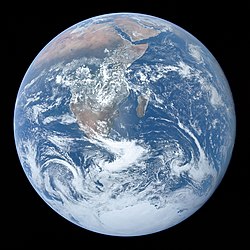
Back Aardplaneet Afrikaans ቋጥኛዊ ይዘት ያላቸው ፕላኔቶች Amharic स्थलीय ग्रह ANP كوكب أرضي Arabic Planeta terrestre AST Плянэта зямнога тыпу BE-X-OLD Земеподобна планета Bulgarian শিলাময় গ্রহ Bengali/Bangla Terestrička planeta BS Planeta tel·lúric Catalan
A terrestrial planet, tellurian planet, telluric planet, or rocky planet, is a planet that is composed primarily of silicate, rocks or metals. Within the Solar System, the terrestrial planets accepted by the IAU are the inner planets closest to the Sun: Mercury, Venus, Earth and Mars. Among astronomers who use the geophysical definition of a planet, two or three planetary-mass satellites – Earth's Moon, Io, and sometimes Europa – may also be considered terrestrial planets. The large rocky asteroids Pallas and Vesta are sometimes included as well, albeit rarely.[1][2][3] The terms "terrestrial planet" and "telluric planet" are derived from Latin words for Earth (Terra and Tellus), as these planets are, in terms of structure, Earth-like. Terrestrial planets are generally studied by geologists, astronomers, and geophysicists.
Terrestrial planets have a solid planetary surface, making them substantially different from larger gaseous planets, which are composed mostly of some combination of hydrogen, helium, and water existing in various physical states.
- ^ Types of Planets (MP4) (Video clip). The Johns Hopkins University Applied Physics Laboratory LLC. 17 July 2020. Retrieved 1 August 2023.
- ^ Emily Lakdawalla (21 April 2020). "What Is A Planet?". The Planetary Society.
- ^ Russell, David (2017). Geophysical Classification of Planets, Dwarf Planets, and Moons (Report). arXiv:1308.0616.



